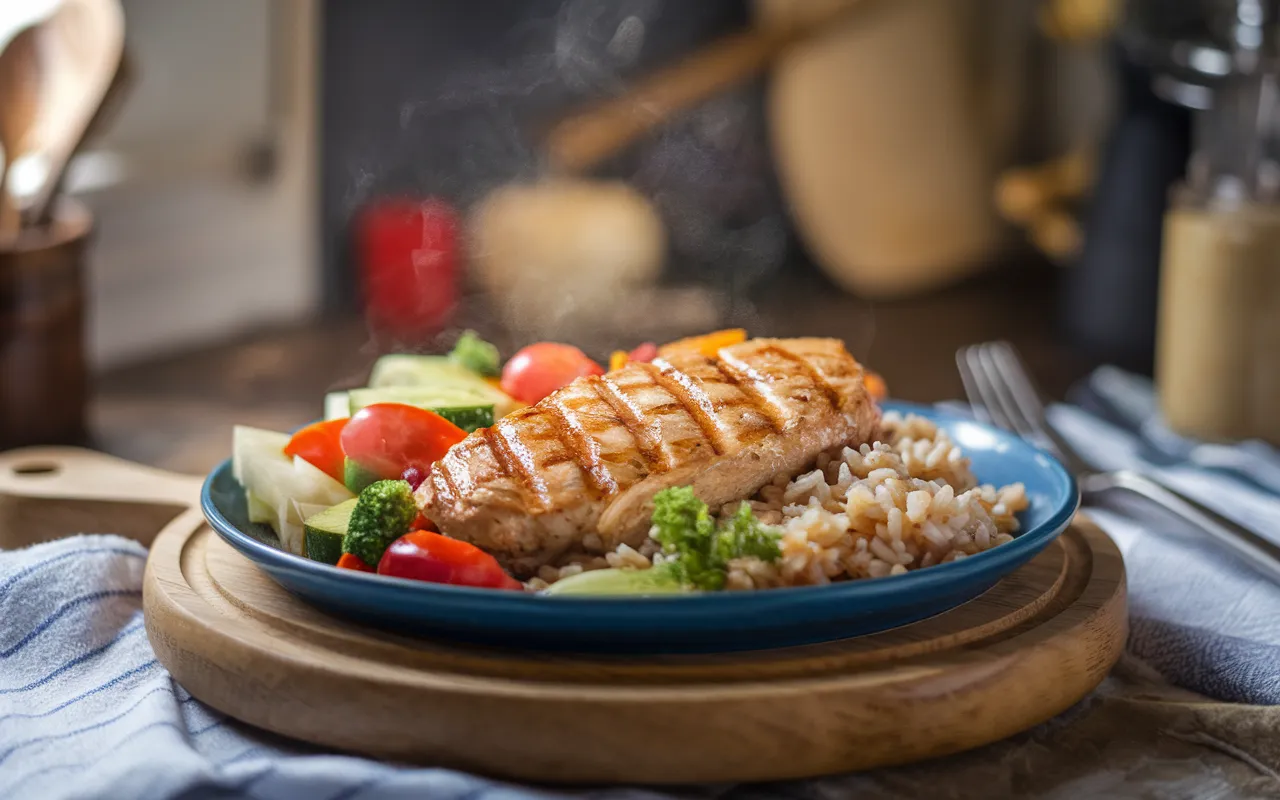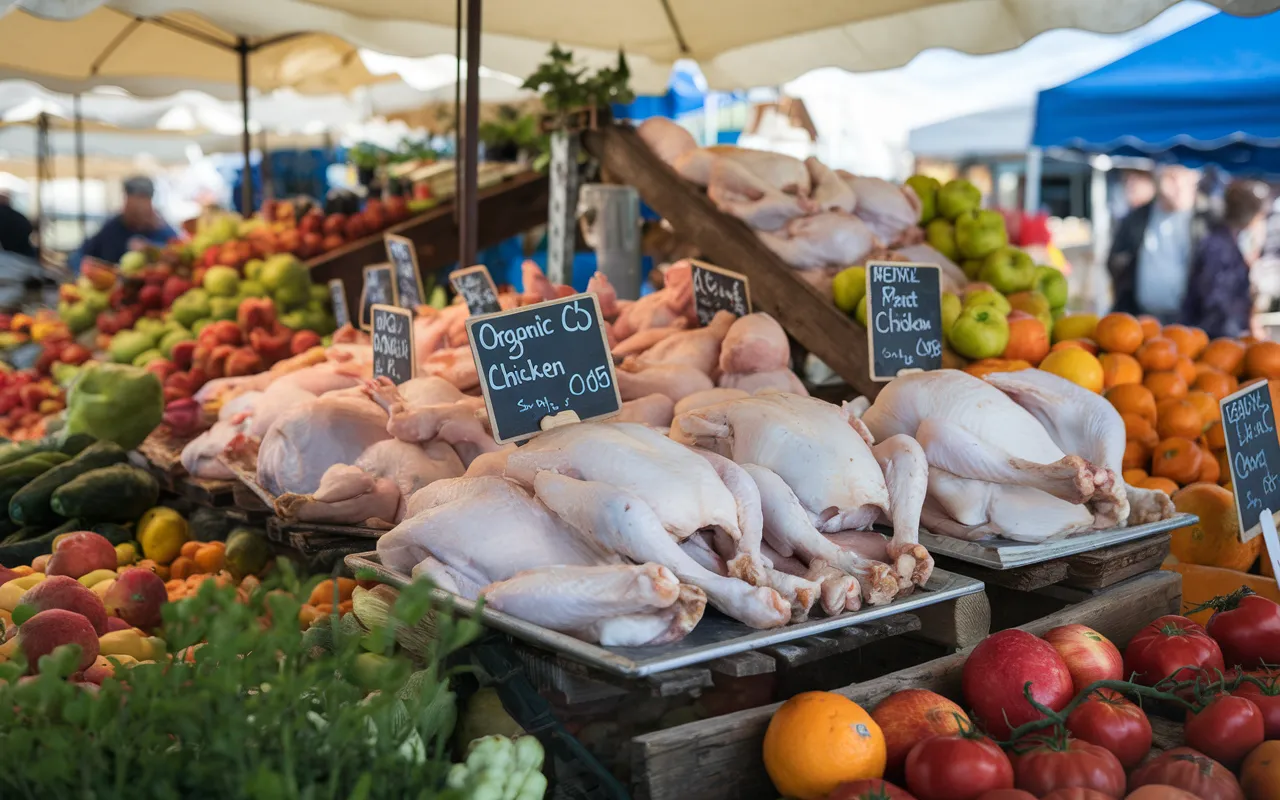Choosing the best and healthiest chicken is essential for anyone aiming to lead a nutritious and mindful lifestyle. The world of poultry offers a wide variety of options, but not all are created equal. This guide delves into the distinctions between chicken types, nutritional benefits, and cooking techniques to help you make informed, healthier choices for your table. Let’s explore how to find the healthiest chicken and make the most of its versatility and flavor.
Understanding the Quest for the Best and Healthiest Chicken
When it comes to finding the healthiest chicken, it’s not just about taste; it’s about understanding where it comes from and how it’s raised. The poultry industry offers various options, each with its unique benefits and drawbacks. But why does this matter so much?
Why Chicken Quality Matters
Quality impacts more than flavor; it also dictates the nutritional value and potential health risks. Chickens raised under natural, humane, and environmentally friendly conditions are more likely to offer higher-quality protein with fewer contaminants.
What Defines ‘Healthy’ Chicken?
A chicken that’s free from antibiotics, raised humanely, and fed a nutritious diet is often considered healthier. These factors play a critical role in ensuring the meat is safe and nutrient-rich. The labels on chicken packages can sometimes be confusing, but terms like free-range, organic, and antibiotic-free often signal healthier choices.
Health Benefits of Choosing Better Chicken
Choosing a high-quality chicken ensures you’re consuming a lean source of protein packed with essential vitamins such as B6 and B12, minerals like zinc and selenium, and amino acids that promote muscle growth and repair. Additionally, it can lower your exposure to harmful chemicals or residues from conventional farming.
Types of Chicken Based on Rearing Practices
The way chickens are raised significantly impacts their quality, flavor, and nutritional value. Let’s break down the primary rearing practices to understand their benefits and shortcomings.
Conventional Chicken Farming Methods
Conventional farming methods dominate the poultry industry, providing affordable and accessible chicken to millions. However, this method often involves intensive farming practices, where chickens are raised in confined spaces with limited mobility.
To maximize production, these chickens are usually fed a grain-based diet supplemented with growth enhancers. While this farming style is cost-effective, it has significant drawbacks, including increased use of antibiotics to prevent diseases and crowded, unsanitary conditions.
These issues can affect the chicken’s nutritional profile, leaving some consumers concerned about the potential presence of contaminants in the meat.
Organic Chicken: Standards and Benefits
Organic chicken offers a healthier, more ethical alternative to conventionally raised poultry. It is produced under strict regulations that ban synthetic fertilizers, pesticides, and genetically modified feed. Furthermore, these chickens are required to have outdoor access, promoting a more humane and natural lifestyle.
Not only is organic chicken tastier, but it also boasts higher levels of nutrients like omega-3 fatty acids while containing fewer harmful residues. Additionally, this method of farming has a reduced environmental impact, relying on sustainable and eco-friendly practices.
Free-Range vs. Pasture-Raised Chicken
The terms free-range and pasture-raised are often used interchangeably, but they’re not the same. Free-range chickens are required to have access to the outdoors, but the quality and duration of that access vary widely. In some cases, the “range” might be a small, fenced area that chickens only occasionally access.
On the other hand, pasture-raised chickens roam freely on open fields, foraging for insects and plants. This results in healthier meat, as the birds are more active and have a natural diet. The meat from pasture-raised chickens tends to be leaner, more flavorful, and higher in essential nutrients.
Understanding these differences can guide you toward choosing a chicken type that aligns with your values and health goals.
The Impact of Antibiotic and Hormone Use in Poultry
One of the most debated topics in poultry farming is the use of antibiotics and hormones. While hormones are banned in poultry farming in many countries, antibiotics are commonly used to prevent diseases and promote growth.
The overuse of antibiotics has sparked concerns about antibiotic-resistant bacteria, which can pose severe health risks to consumers. Choosing antibiotic-free chicken not only ensures safer meat but also supports more ethical farming practices.
By opting for chickens raised without antibiotics or hormones, you’re making a conscious decision to prioritize both your health and the environment.
Nutritional Comparison of Chicken Parts
Chicken offers a versatile source of protein, but not all parts are nutritionally equal. Let’s explore how white meat and dark meat compare and whether skin-on or skinless options are better for your health.
White Meat vs. Dark Meat: Which is Healthier?
The choice between white and dark meat often boils down to personal preference, but the nutritional differences are worth noting. White meat, found in the chicken breast, is leaner and contains fewer calories and fat. It’s a go-to choice for those looking to maintain a low-fat diet.
Dark meat, sourced from the thighs and drumsticks, is slightly higher in fat but richer in iron and zinc. Its robust flavor and juiciness come from the additional fat content, making it a favorite for many culinary dishes.
While white meat is often considered healthier for heart health, the fats in dark meat are mostly unsaturated, which are beneficial in moderation. Choosing the right cut depends on your dietary needs and cooking preferences.
Skin-On vs. Skinless Chicken: Nutritional Implications
The chicken skin debate revolves around flavor versus health. Skin-on chicken provides a richer taste and juiciness, as the skin locks in moisture during cooking. However, it also adds saturated fat and calories to the meat.
Skinless chicken, on the other hand, is a leaner option, making it ideal for those aiming to reduce fat intake. It pairs well with lighter cooking methods like steaming or poaching.
If you’re craving skin-on chicken, grilling or baking can help minimize excess fat while retaining flavor. Remember, moderation is key to enjoying the best of both worlds!
Healthiest Cooking Methods for Chicken
The way you cook your chicken plays a crucial role in retaining its nutritional value while minimizing harmful effects. Let’s delve into the healthiest techniques and methods best avoided.
Grilling and Baking: Pros and Cons
Grilling and baking are two of the most popular methods for preparing chicken, and for good reason. These techniques preserve the chicken’s natural flavors without requiring excessive oil or added fats.
Grilling:
Grilled chicken is a favorite for its smoky flavor and attractive char marks. It’s an excellent way to lock in nutrients and achieve a satisfying texture. However, over-grilling can lead to the formation of harmful compounds like heterocyclic amines (HCAs), especially when the chicken is exposed to high heat for extended periods.
Baking:
Baking chicken in the oven is another healthy choice, as it requires minimal oil. You can enhance the flavor with herbs, spices, and a splash of lemon juice. Baking also allows for even cooking without creating potentially harmful compounds. One downside is that it may take longer compared to other methods, but the result is worth the wait—a juicy, flavorful dish.
Steaming and Poaching for Optimal Health
When it comes to preserving the best and healthiest chicken qualities, steaming and poaching reign supreme. These methods involve cooking chicken in water or steam, which helps retain nutrients and minimize the need for added fats.
Steaming:
Steaming is a gentle cooking method that keeps the chicken moist and tender. It’s ideal for those aiming for a low-calorie, clean-eating lifestyle. Plus, you can infuse the chicken with flavors by adding herbs or aromatics like ginger and garlic to the steaming liquid.
Poaching:
Poaching involves simmering chicken in a flavorful broth or water. This method is particularly great for making shredded chicken for salads, sandwiches, or soups. It maintains the natural tenderness of the meat while being virtually fat-free.
Both methods allow you to enjoy chicken in its most natural and nutrient-dense form, making them perfect for health-conscious individuals.
Methods to Avoid: Frying and Charbroiling
While fried chicken might be a crowd-pleaser, it’s far from the healthiest choice. Deep-frying introduces excessive fats and calories, which can counteract the benefits of the lean protein chicken provides. In addition, frying often involves the use of unhealthy oils, which may contain trans fats.
Charbroiling, on the other hand, exposes chicken to direct flames, which can create carcinogenic substances like polycyclic aromatic hydrocarbons (PAHs). While the crispy, smoky flavor is tempting, the risks outweigh the benefits, especially when consumed frequently.
For a balanced approach, enjoy fried or charbroiled chicken as an occasional indulgence rather than a dietary staple. By focusing on healthier cooking methods, you can fully enjoy the flavor and nutrition of chicken without compromising your health.
Next, we’ll explore how to select the best chicken at the market to ensure your meals are as wholesome as they are delicious.
Selecting the Best Chicken at the Market
Choosing the best and healthiest chicken at the market can be overwhelming with so many options and labels. Understanding what to look for ensures you’re bringing home quality poultry that meets your health and ethical standards.
Decoding Chicken Labels: What to Look For
The labels on chicken packaging can be confusing, but they hold vital information about how the chicken was raised and processed. Here’s a breakdown of the most common terms to look for:
- Organic: Chickens labeled organic are raised without antibiotics, fed organic feed, and have outdoor access. This ensures healthier meat and supports sustainable farming practices.
- Free-Range: This label means the chicken had access to outdoor areas, though the extent and quality of that access vary. Free-range often signals better living conditions than conventional methods.
- Pasture-Raised: This signifies that chickens spent a significant amount of time outdoors, foraging for natural food. Pasture-raised chickens tend to be more nutritious and flavorful.
- Antibiotic-Free: Indicates that no antibiotics were used in the chicken’s rearing process. Opting for antibiotic-free chicken helps reduce the risk of consuming antibiotic residues and supports overall health.
- No Added Hormones: Although the use of hormones in poultry is banned in many countries, this label reassures consumers that the chicken is hormone-free.
By carefully reading labels, you can align your purchase with your health goals and ethical preferences. For more details about poultry standards, visit Understanding Organic Poultry Standards.
Recognizing Freshness and Quality Indicators
Aside from labels, assessing the freshness and quality of chicken is essential. Fresh chicken should meet the following criteria:
- Color: The meat should be pale pink with no discoloration or grayish tones.
- Texture: Fresh chicken feels firm to the touch. Avoid chicken that feels slimy or overly soft.
- Smell: There should be no unpleasant or sour odor. Fresh chicken has a mild, neutral scent.
- Packaging: Look for sealed, intact packaging with no excess liquid pooling inside. Excess liquid can indicate poor handling or a loss of freshness.
Shopping for chicken at reputable markets or butchers can also ensure better quality. These sources often prioritize freshness and ethical sourcing practices.
By understanding labels and quality indicators, you’ll make informed choices that guarantee a more nutritious and delicious meal. Next, we’ll address frequently asked questions to clear up any lingering doubts about choosing and cooking the healthiest chicken.
Frequently Asked Questions
Many people have questions about how to select and prepare the best and healthiest chicken. Let’s answer some of the most common queries to clear up any confusion.
What’s the difference between free-range and pasture-raised chicken?
While both labels suggest better living conditions than conventional farming, they differ significantly. Free-range chickens must have access to the outdoors, but the quality and duration of that access vary. Pasture-raised chickens, however, spend most of their time roaming open fields, foraging naturally. This often results in healthier, tastier, and more nutrient-rich meat.
Is organic chicken always the healthiest choice?
Organic chicken is raised without antibiotics, synthetic pesticides, or genetically modified feed, making it a cleaner option. However, it might not always be the healthiest choice if it’s poorly cooked or paired with unhealthy ingredients. The method of preparation plays a significant role in how healthy the chicken is on your plate.
Can I still eat chicken skin if I’m trying to eat healthy?
Yes, but in moderation. Chicken skin adds flavor and juiciness but also contains extra calories and saturated fat. If you’re concerned about your fat intake, consider removing the skin after cooking to retain the moisture it provides during the cooking process without consuming all the fat.
How can I tell if chicken is safe to eat?
Always ensure chicken is cooked to an internal temperature of 165°F (74°C). Use a meat thermometer to check, as undercooked chicken can harbor harmful bacteria like Salmonella. Additionally, avoid leaving raw chicken out at room temperature for extended periods.
Which cooking method is best for retaining chicken’s nutrients?
Steaming and poaching are the best methods for preserving nutrients, as they avoid high temperatures and excessive oil. Grilling and baking are also excellent choices when done correctly, but deep-frying should be avoided to minimize unhealthy fats.
What should I look for when buying chicken?
Focus on labels like organic, antibiotic-free, or pasture-raised. Check the freshness by inspecting the color, smell, and texture of the meat. Always buy from reputable sources to ensure quality.
Having clear answers to these questions can help you make better choices and enjoy the full benefits of chicken in your diet. Next, we’ll wrap up with a summary of the journey to finding the healthiest chicken.


